Travel and Culture:
The Ringling International Arts Festival
By Cornelia Seckel
ART TIMES Jan/ Feb 2011
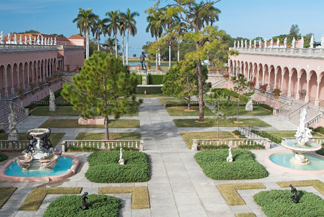 John and Mable Ringling Art Museum inner courtyard, Sarasota, Florida John and Mable Ringling Art Museum inner courtyard, Sarasota, Florida |
Several months ago I had an email inviting me to be the guest of the Sarasota Convention and Visitor’s Bureau www.sarasotafl.org to attend the Ringling International Arts Festival (www.ringlingartsfestival.org) in Sarasota, Florida. It was to be 5 days of over 100 artists presenting 45 mainstage productions in 4 venues on the Ringling Campus —a total of 60 events. Artists came from the Czech Republic, Slovakia, Britain, Russia, Romania, Canada and the US.The Festival is a collaboration between The John and Mable Ringling Museum of Art www.ringling.org and the Baryshnikov Arts Center, NYC www.bacnyc.org, established in 2005 to house the core activities of the Baryshnikov Dance Foundation, incorporated in 1979 by Mikhail Baryshnikov. BAC serves as a creative laboratory, meeting place, and performance space for a vibrant community of artists from around the world. BAC is also dedicated to building audiences for the arts by presenting contemporary, innovative work at low or no cost to the public. Accepting this invitation was an opportunity to see the Art Museum, hear music, see plays and dance performances, talk to new people and explore new places. Mikhail Baryshnikov would be dancing. How could I refuse?
I flew into Tampa from Newburgh, NY (such a convenient airport), got a car and headed down to Sarasota. My hotel was the brand new Hampton Inn right next to the Sarasota Bradenton Airport (this would have been my first choice to fly into but the schedules just didn’t work for me). This is the newest of the Hampton Inn & Suites (you see them across America at most every exit off major highways) and became the first Hampton Inn and Suites in the country to earn the prestigious certification awarded by the US Green Building Council for energy efficient and sustainable buildings. The hotel developers, Finergy Development LLC, strove to reduce the environmental impact of the project from the point of site selection, throughout the construction process, up to the day-to-day operations of the hotel. (www.hamptoninnsrq.com). Michelle Siese, General Manager, was welcoming and gracious. I was concerned about the noise level next to this International airport with major daily scheduled service from domestic and commuter airlines. Michelle had assured me that the airplanes were not heard inside the Inn and I never heard one. The location was perfect as I could walk the ½ mile to the Ringling Campus —I say campus because in July 2000 The John and Mable Ringling Museum of Art comprising 66 acres and buildings were turned over to Florida State University, a decision that worked well for the Museum’s fiscal health. One can fly to Sarasota, visit the museum, get public transportation to the beach or any of the many attractions (or transportation from any of the ½ dozen hotels within walking distance of the airport) and never need to rent a vehicle.
Native Americans lived along the waterfront of Sarasota more than 3,000 years ago. In the 1500’s Ponce de Leon, Panifilo Narvaez and Hernando De Soto arrived from Spain looking for silver and gold and found the Seminole Indians. In 1824 the US acquired the territory of Florida and in the 1880’s development began. Sarasota, located on the gulf coast of Southwest Florida, was promoted in Scotland and many families came to settle but left when all they found was an unpaved main street, no citrus groves or housing. A few people, John Hamilton Gillespie (first mayor of Sarasota) stayed and began to develop the town. By 1910 wealthy Americans were attracted to the area and in 1912 John and Mable Ringling began spending their winters in Sarasota.
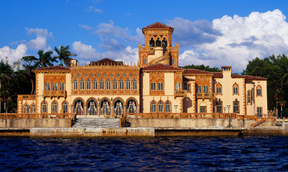 Cà d'Zan home of John and Mable Ringling Cà d'Zan home of John and Mable Ringling |
John Ringling and 4 brothers joined together to start the Ringling Bros. Circus (noted for their Menageries) in 1884. John had begun his circus career at 16, performing as a song and dance man. Given his great organization skills, he soon oversaw the circus route. By 1907 Barnum & Bailey (noted for their Sideshow) joined forces and the Circus continued to be a world-class show crossing the country with four trains and 100 rail-cars each season. By 1927, Ringling moved the circus’ winter quarters to Sarasota and then opened it to the public significantly increasing area tourism. Ringling by now was a very wealthy man and bought railroads, real estate, and a lot of art. With his wife, Mable, Ringling began accumulating a collection of Old Master paintings that they displayed in their homes in New York City; Alpine, New Jersey; and then in Sarasota on the bay where they built Cà d’Zan (House of John) which was completed in 1925. In NY they found furnishings, tapestries, and paintings from the homes of wealthy and prominent families and bought them at various Auctions. By the 1920s, the Ringlings were traveling annually to Europe to locate new circus acts, and made many purchases of art objects and in fact entire rooms including the Asolo Theatre, an 18th-century treasure created in Asolo, Italy in 1798. In the late 1940s, the theater was dismantled and brought to the Ringling Estate in Sarasota.
After arriving at the Hampton Inn and settling myself I headed to the beach by way of a restaurant well known for seafood. I picked up delicious crab cakes (I was on a coast—what else would I choose but fish?) and headed over to Lido Beach and dip my toes into the cool clear gulf. I had to get back early in time for the Night of Premieres Gala. First, a champagne toast for all attending the gala, and then off to 4 different venues and events: “Hurricane” by Nilo Cruz, Solos with Mikhail Baryshnikov and David Neuman, Tim Fain violin solo of work by Philip Glass and J.S. Bach, and Forman Brothers Theatre Opera Baroque. I went to see the world premiere of “Hurricane”, a play commissioned by the Ringling International Arts Festival (RIAF) and held in the Historic Asolo Theater. Briefly, the play takes place in a hurricane and looks at the lives and relationships of a husband and wife and their son. The father had been injured in an accident that left him in a wheel chair with amnesia. His health was restored at the expense of the son’s life during the hurricane. It is still a hurricane in my mind. The set, the noise, the lightning, all made a huge tumult throughout the play, strong emotions, soul searching and redemption. As any fine work should, it is still with me, as does the idea that Hurricanes destroy lives, change lives and make one question who they are and what they are doing.
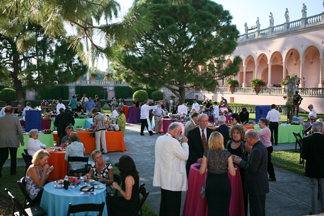 The Gala Reception for the Ringling International Arts Festival in Sarasota Florida The Gala Reception for the Ringling International Arts Festival in Sarasota Florida |
After the play I met Karen Kopp, my media escort for the duration of the RIAF. What a delightful person and guide. Karen, a student of art history for the past 40+ years and a full docent in both the Museum and the Mansion, brought me to the inner courtyard of the museum where over 1200 guests including participating artists, sponsors and the paying public enjoyed excellent food from the Trevisio Restaurant (housed on the Ringling campus), music by DeLeon Big Band and fabulous fireworks by Bell’s Fireworks. The evening was sponsored by Board Chairman Senator John & Mrs. Michele McKay and Tana Sandefur, board member. The City of Sarasota, Sarasota Convention and Visitors Bureau (SCVB), and Anna Maria Island & Longboat Key were the main benefactors of the evening with over 30 additional patrons and supporters. We ate, drank, danced to the excellent music and then watched the fireworks as they splayed out behind the museum with a statue of David in the foreground. I met several people and had a chance to speak with some of the dancers and actors I would see in the next few days. What a celebration and way to begin this Festival.
The following morning (Thursday) I met up with Erin Duggan from the SCVB for breakfast and she mentioned the terrific job one of ART TIMES’ writers did for Sarasota’s Art Festival in 2007. Laurie Spiegel wrote an excellent piece about that festival and some of what Sarasota has available to the culturally-minded. That report is still available at: www.arttimesjournal.com/Travel_and_Culture/Sarasota_
April_07_Laurie_Spiegel/Sarasota_Winter_Art_Scene.htm. We spoke about the current tourist concerns of the oil spill. The oil never reached Sarasota and didn’t affect any of the sea life. There was some spotting of oil in the panhandle of Florida but people seem to be unaware that the waters are safe for wildlife and perfect for swimming, boating, and beach combing. Erin suggested some additional activities might be of interest to me. When she mentioned Kayaking I immediately smiled and took her up on the offer of a guided tour through the mangroves in Sarasota Bay.
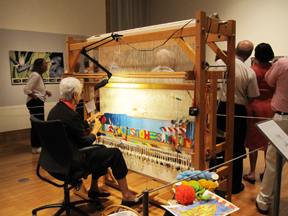 The Tapestry Demo by Becky Stevens as part of the "Golden Threads" exhibit at The John and Mable Ringling Art Museum The Tapestry Demo by Becky Stevens as part of the "Golden Threads" exhibit at The John and Mable Ringling Art Museum |
After breakfast I met Karen at the Ringling Museum's Visitors Pavilion, which also houses the Historic Asolo Theater as well as the Museum store, and Treviso Restaurant. We headed over to the museum where we heard an excellent lecture on the Threads of Gold, an exhibition of eight tapestries that are on tour from Vienna’s, Kunsthistorisches Museum’s collection. Made in the 16th century, several belonged to the Emperor Franz I (1708–1765), husband of Empress Maria Theresia (1717–1780). All of the tapestries were recently restored. They depict one of the most popular secular themes in the sixteenth-century repertoire of Flemish tapestry production: the legendary founding of ancient Rome by the twins, Romulus and Remus and are woven with gold and silver. It was quite an education for me. As there were no books, people learned from the stories told in paintings and tapestries. They also had much practical use, providing insulation for castle walls, covering openings and giving privacy around beds. Also on display were 5 tapestries of Sarasota weavers and a loom with a weaver demonstrating the current method and explaining how that was different from the looms that 5-20 people might be working on at the same time. It was interesting to then see some of Peter Paul Rubens’ cartoons (paintings from which tapestries were executed) in the art museum. He worked closely with Bravant & Brussels Company in their manufacturing of Tapestries. A number of years ago we visited Rubens’ home in Antwerp, Belgium, an elegant Renaissance Baroque home and gardens. He lived and worked in this house from 1616 until his death in 1640. The Tapestry exhibit will be at the museum until January 2, 2011.
After lunch at the Treviso Restaurant we toured the Circus Museum and the Tibbals Learning Center that houses the world's largest miniature circus with a replica of Ringling Bros. and Barnum & Bailey Circus from 1919 – 1938. The Howard Bros. Circus was created over a 50-year period by master model builder and philanthropist Howard Tibbals. There are eight main tents, 152 wagons, 1,300 circus performers and workers, more than 800 animals and a 57-car train. I was fascinated by the details, the individual plate settings in the eating areas, the tent where the performers got dressed, the menagerie, even the parking area with vintage cars. This is a must see when you are in Sarasota.
From this phenomenal experience we went to Cà d’Zan to tour the “house”, a home that was comfortable for circus people with its elaborate furnishings. It was built to the specifications of Mable who brought postcards, sketches, photos and other materials that she gathered on her travels to aid the architect with his design. The house was designed with great influence from the Doge’s Palace in Venice. We could visit the various rooms and since Karen was the “lace lady” that repaired the lace on the bedspread and pillows in Mable’s room I learned a lot. John Ringling lost most of his fortune during the crash. With his passing in 1936, he gave the entire museum including his art collection and the house to the state. By the 1990's, major renovations needed to be done, especially to the house.
Late in the afternoon (as I did each afternoon) I went to Cà d’Zan patio where Les DaCosta Jazz Quintet played while I (and several hundred others) watched the sunset. The first night was a dedication of the new waterfront promenade that was underwritten by David F. Bolger. This beautiful spot, overlooking the Sarasota Bay, is perfect for parties, music and perhaps performances.
In the evening I saw the play “The Boys” by The Theatre Art Studio, the highly acclaimed and youngest theatre company in Moscow. Their mission is to perform rare and little known works by classical authors. The excellently performed play (every performance I attended was of the highest professional level even though they were relatively new and emerging troupes) was from 9 chapters from the Brothers Karamazov by Dostoevsky. It was heavy, it was intense, it was powerful.
Friday found me meeting with Dwight Currie, Festival Director and the Museum’s Interim Deputy Director for Collections, Programs and Exhibitions for a briefing on the Festival. My question: “How did Baryshnikov get involved?” Dwight told us that on any given night in season (now December-April) there are 7,000 tickets available for performances in Sarasota area and there are 200,000 + people. There is the Sarasota Ballet, The Sarasota Orchestra, The Sarasota Opera, The Asolo Repertory Theatre, Van Wezel Performing Arts Hall, Florida Studio Theatre, Venice Theatre, Banyon Theatre Company, Florida Studio Theatre, Towles Court Artist Colony, Golden Apple Dinner Theatre, and The Players Theatre. So why create something else? Why not? But not in Season. After Season people are tired and they need a break. In October, before the Season begins is a good time to bring additional people to Sarasota and as a pay back to the community. Ticket prices average $30-$40 per performance and packages for several performances are quite reasonable. To date they were 20% over the expected sales. There are 13,000 young people in local colleges and some tickets were provided for students by donors who believe that there is a great need to change the hair color of the audience. John Ringling’s mission was about education and this surely continues that mission. They needed a name to bring people in. Baryshnikov has an art center in NYC that is concerned with emerging middle career artists. The museum people thought it might be a match. Baryshnikov came to Sarasota to explore the possibilities and when he walked on to the stage of the Asolo Theatre he said “this will do” and the collaboration began. Baryshnikov is the artistic director and wanted no formulas, just new enervative work by emerging artists from around the world. It was a continuation of the BAC mission. If there was any festival that they modeled themselves after it was the Edinburgh Festival and as with many festivals, there are side festivals that crop up in the community.
There is still a strong commitment to the circus families (Show Folks) who live nearby and come together for an annual event. In Sarasota there are still many Circus related activities: Circus Sarasota, PAL’s Sailor Circus — a youth circus, Circus Ring of Fame and the Flying Trapeze Academy & Flying Fantasy Circus.
Dwight gave us much more time than he had scheduled and when we left him we headed over to the Circus Museum by way of Mable’s award winning Rose Garden. The Circus Museum had Ringling’s private railcar, several wagons, posters, and costumes (many Karen had repaired and created new ones for visiting students).
We stopped at The Circus Museum, a museum that celebrates the American circus, its history and unique relationship to Sarasota. Established in 1948, the museum was the first in the county to document the rich history of the circus. Circus performers made their homes in Sarasota and brought a unique diversity to the area — Cristianis, Concellos, Merle Evans, Lou Jacobs, Emmett Kelly, LaNorma, Unus, Wallendas, and Zacchinis. They are an integral part of the community and the circus became a part of Sarasota County's ongoing legacy.
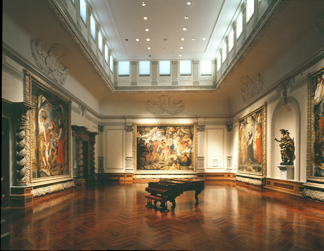 The Peter Paul Rubens Gallery in The John and Mable Ringling Art Museum The Peter Paul Rubens Gallery in The John and Mable Ringling Art Museum |
Afterwards, we headed over to the Art Museum to have a more thorough tour. The John and Mable Ringling Arts Museum was built by John Ringling to house his personal collection of masterpieces. In 1931 it was officially opened to the public. As we went from room to room it was again made clear that the range of art gave a strong overview of art history. The collection of Peter Paul Rubens is considered by many to be the finest in the world. In 2006, a combined endowment, building and collection gift from noted Asian art collector and philanthropist Dr. Helga Wall-Apelt, substantially bolstered the Ringling Museum’s Asian art initiative which aims to establish the Museum as an important venue in Florida for the study of Asian Art. The Courtyard of the Museum of Art (where the Gala was held) features casts of original antiquities and renaissance sculptures, including the towering David by Michelangelo. The Courtyard features two fountains - Fountain of Tortoises, one of three replicas from the Piazza Mattei in Rome, and the Oceanus Fountain, copied from the 16th century original by Giovanni Bologna in Florence’s Boboli Gardens. When John died in 1936, he bequeathed his art collection, mansion, and estate to the people of Florida.
With reluctance and an extracted promise that we would meet again, I left Karen and went to the Circus Museum to see the Forman Brothers Theatre Opera Baroque. The Forman Brothers’ Theatre is a theatre without permanent stage and a complete ensemble, “a community of theatrical nomads and comedians who relish the charm of journey and travels”. They travel around Europe with their stagings; they play in various spaces that have been created just for the project. They were very much in the manner of the Circus: entertainment as you enter, antics with the audience, a performance, more antics. The Marionette Show, so much a part of the Prague heritage, was an opera from the end of the 18th Century called “The Quarrel between the Landlord and the Masons”. Excellent, fun and had the audience laughing throughout.
For me the piece de resistance was the Solos with Mikhail Baryshnikov and David Neumann. Only 1 hour long, 5 pieces and exquisite excellence. Standing room only and as I looked around I saw many guest dancers standing in the aisles. Whether they were walking (as in the first collaborative piece) or dancing solo, seeing these two was the highlight for me. My focus was on Baryshnikov and the last piece he did, “Years Later”, had him dancing with his younger self that was projected on a large scrim. Choreographed by Benjamin Millepied, the piece was courageous, humorous, and generous. I was bursting with emotion for hours after the performance and when I saw Baryshnikov later that evening as he was posing for a group picture with young Russian dancers and actors, I greeted him and expressed my appreciation for his generosity in dancing for us and for being the artistic director of the Festival —he seemed pleased.
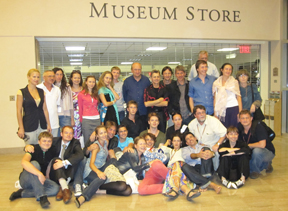 A Mikhail Baryshnikov (standing center )with Actors and Dancers courtesy of the Baryshnikov Art Center, NYC A Mikhail Baryshnikov (standing center )with Actors and Dancers courtesy of the Baryshnikov Art Center, NYC |
Two hours later and after some “Coming Down” time I saw Loan Sharking by the Rubberbanddance, a Group from Montréal, Canada; Co-Artistic Director, Choreographer & Dancer is Victor Quijada. Their movements were so fluid and intense that I was at the edge of my seat once again.
Late evening fare was Sanda & the Takeishis Gypsy in a Tree, with music by Sanda Weigl, a blending of gypsy music, cabaret and jazz. It was at this time that I was able to get a picture of Mikhail Baryshnikov and dancers and actors from Russia many of whom would perform in NY at the Baryshnikov Art Center.
Saturday morning and I was heading towards Lido Beach (a mere 5 miles from my hotel) and the South Lido Mangrove Tunnels Tour with David Wells from Almost Heaven Kayak Adventures www.kayakfl.com. It was a 2.5-hour exploring of Mangrove Tunnels and David was quite attentive to each of the kayakers pointing out Manatee feeding grounds, live shells sea stars, and sea cucumbers. We didn’t see any Dolphins or Manatees but they are often seen during this trip. It was a beautiful day with waters clean and clear as crystal. Kayaking is a delightful way to explore the shorelines. Perhaps next time I’m in Sarasota I’ll take the guided fishing trips, or perhaps the Gulf of Mexico Expeditions, and then there is the Bird Watching trip. So many choices.
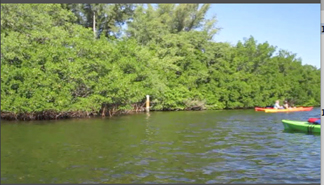 Kayaking in the South Lido Mangrove Tunnel, Kayaking in the South Lido Mangrove Tunnel,Sarasota, Florida |
Late in the afternoon I met up with Elaine Jaffe, a friend from home who winters in Venice and she accompanied me to the last two Dance programs and a final (for now) look at the sunset in Sarasota Bay with lovely Jazz playing in the background. We saw Les Slovaks Dance Collective, a group of 5 Slovak dancers and a violin player who live in Brussels. Their performance, which is structured and impromptu, is just delightful as they tease, antagonize and play with one another. The Company focus is on performing and dancing.
The final performance of the Festival for me was Magic, Mystery, and other Mundane Events by the John Jasperse Company who are based in the US. So many different dances styles delighted and totally engaged the audience.
The Museum Campus includes the Art Museum, Cà d’Zan, the Historic Asolo Theater, the Circus Museum and the Tibbals Learning Center. At one time the Ringling School of Art (now The Ringling College of Art and Design, a private, not-for-profit, fully accredited college) was to be housed on the campus but money ran out and it is located less than 2 miles from the Museum. It was John’s intention from the beginning to have a museum and school where students could learn to draw from the model (he bought 3000 sculptures) and study work from different periods of art history. His purchases were all to that end. There are 240 staff members, over 750 volunteers, 150 docents and a huge program for children with 10 school tours a week and over 13,000 kids a year visiting the museum. An extensive Art Library is available to the public.
Sarasota is 2nd to NYC per capita of people employed by the arts. Per capita there are more performing arts seats than in NY on a given night during the season. What a place to stay away from the cold. And the beaches…………… some of the most beautiful in the world. And then there is the tour of historic buildings and The Sarasota School of Architecture, sometimes called "Sarasota Modern," a regional style of post-war architecture that emerged on Florida's Central West Coast and is characterized by its attention to climate and terrain.
I never did get to some of the productions at the RIAF, the family fest, the library, or the Johnson-Blalock Education Center. I guess I’ll just have to return. Tickets for the 3rd Annual RIAF will go on sale early in 2011. Most every performance was sold out so go online and secure your tickets for a most fabulous festival. www.ringlingartsfestival.org/performances/
Look for the video on the ART TIMES homepage www.arttimesjournal.com and also on YouTube
